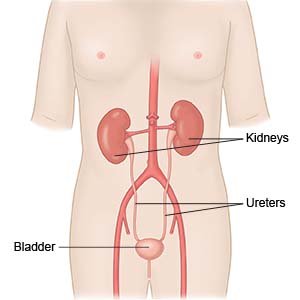Percutaneous Nephrolithotomy
Medically reviewed by Drugs.com. Last updated on Aug 4, 2025.
WHAT YOU NEED TO KNOW:
Percutaneous nephrolithotomy is surgery to remove kidney stones.
 |
HOW TO PREPARE:
The week before your surgery:
- Arrange to have someone drive you home after your surgery.
- Tell your surgeon about all medicines you currently take. He or she will tell you if you need to stop any medicine for surgery, and when to stop. He or she will tell you which medicines to take or not take on the day of surgery.
- You may be given antibiotics to help prevent an infection caused by bacteria. Tell your surgeon if you had an allergic reaction to antibiotics.
- Contrast liquid may be used during your surgery to help your surgeon see the kidney better. Tell him or her if you have ever had an allergic reaction to contrast liquid.
- You may need to have blood and urine tests. You may also need an ultrasound and x-rays of the urinary tract, or a CT scan.
The night before your surgery:
You may be told not to eat or drink anything after midnight.
The day of your surgery:
- You or a close family member will be asked to sign a legal document called a consent form. It gives healthcare providers permission to do the procedure or surgery. It also explains the problems that may happen, and your choices. Make sure all your questions are answered before you sign this form.
- Take only the medicines your surgeon told you to take.
- An IV will be placed into a vein. You may be given medicine or liquids through the IV.
- An anesthesiologist will talk to you before your surgery. Tell him or her if you or anyone in your family had a problem with anesthesia. General anesthesia will be given to keep you asleep and free from pain during surgery.
WHAT WILL HAPPEN:
What will happen:
An incision will be made in your back. A nephroscope will be put through the incision and into your kidney near the stone. The nephroscope is a long tube with a magnifying glass and a light on the end. Healthcare providers may use x-rays or an ultrasound to help guide the scope. The nephroscope and other tools will be used to gently remove the stone. A machine such as a lithotriptor or an ultrasound may be used to break the stones into smaller pieces. The stone will be sent to the lab for tests. The incision will be closed with stitches or surgical tape.
After your surgery:
You will be taken to a room to rest until you are fully awake. Healthcare providers will monitor you closely for any problems. Do not get out of bed until your healthcare provider says it is okay. When your healthcare provider sees that you are okay, you will be taken to your hospital room.
- Your incision will be covered by a bandage. This bandage keeps the area clean and dry to help prevent infection. A healthcare provider may remove the dressing soon after surgery to check the incision.
- It is normal for urine to leak out of the incision for a few days after surgery.
CONTACT YOUR HEALTHCARE PROVIDER IF:
- You have a fever.
- You get a cold or the flu.
- You have questions or concerns about your surgery.
Risks
You may get an infection or bleed more than expected. You could have trouble breathing. Organs such as the liver, lungs, and spleen could be damaged during surgery. Scars may form where the stone was removed. Healthcare providers may not be able to remove your kidney stone, and you may need another surgery. You may develop a life-threatening blood clot.
Related medications
Care Agreement
You have the right to help plan your care. Learn about your health condition and how it may be treated. Discuss treatment options with your healthcare providers to decide what care you want to receive. You always have the right to refuse treatment.© Copyright Merative 2025 Information is for End User's use only and may not be sold, redistributed or otherwise used for commercial purposes.
The above information is an educational aid only. It is not intended as medical advice for individual conditions or treatments. Talk to your doctor, nurse or pharmacist before following any medical regimen to see if it is safe and effective for you.
Further information
Always consult your healthcare provider to ensure the information displayed on this page applies to your personal circumstances.
